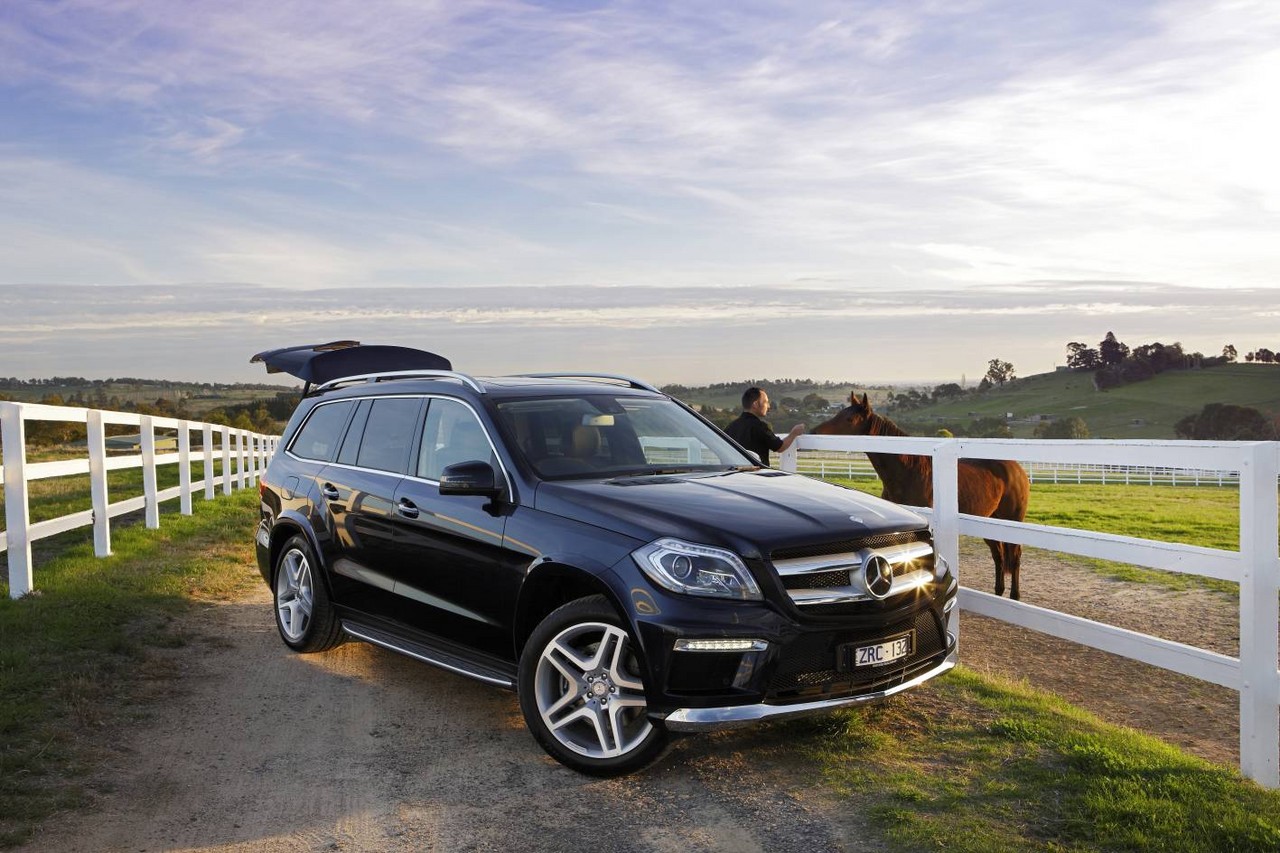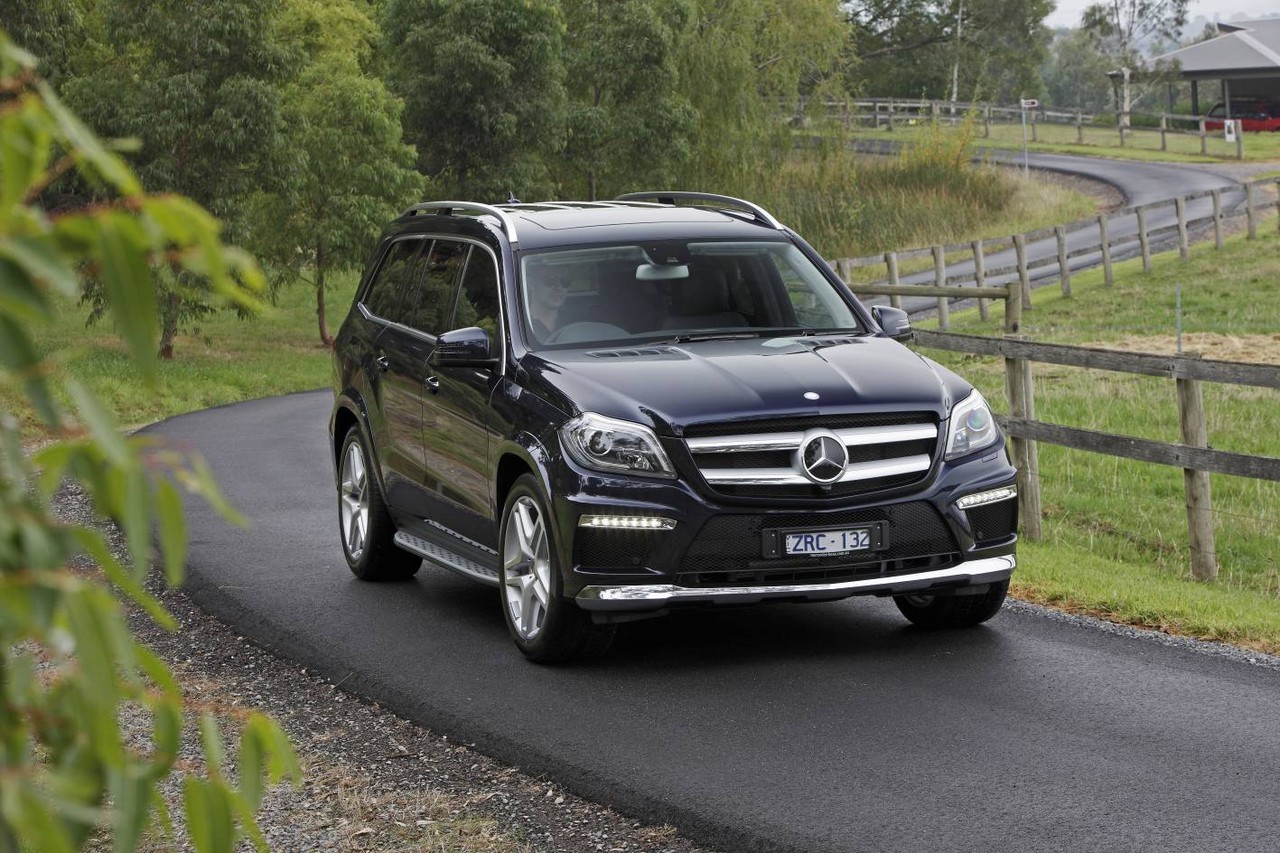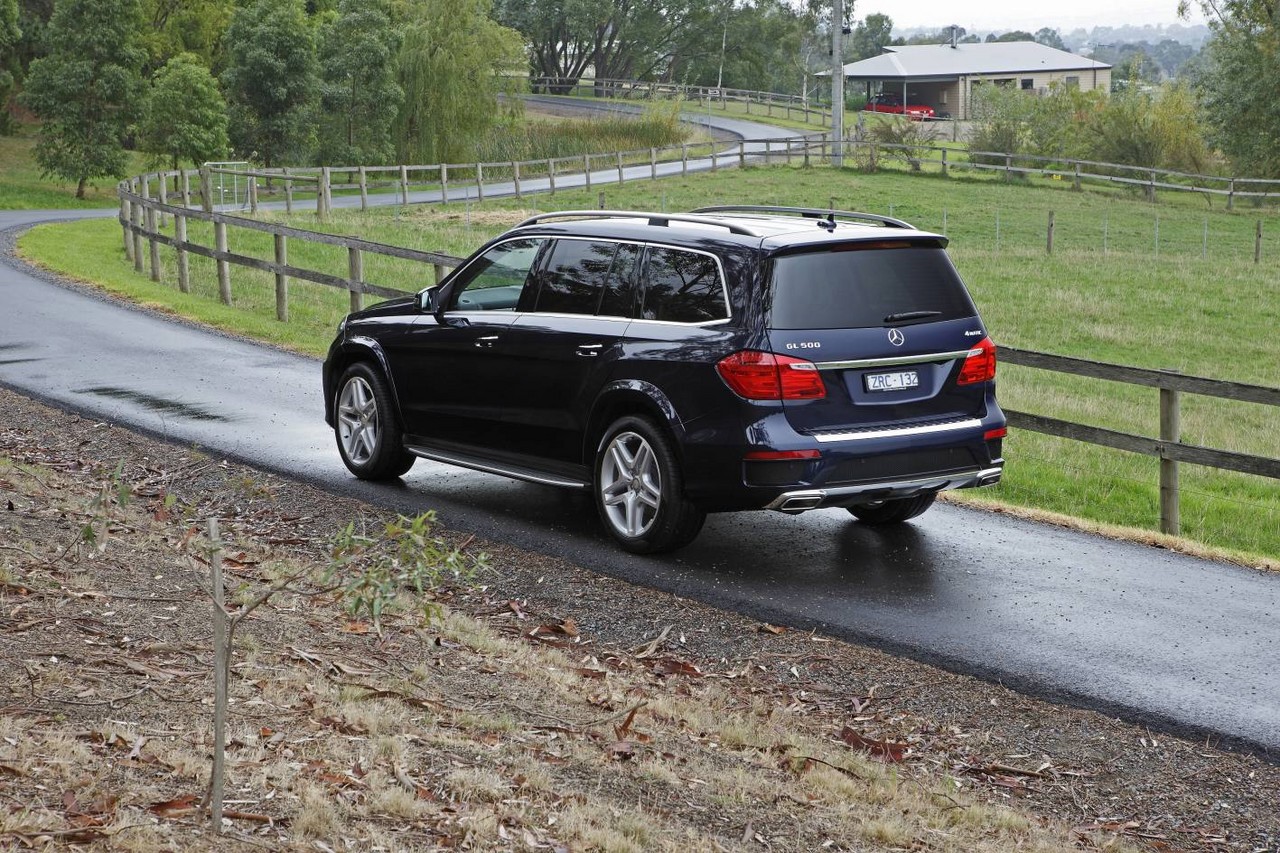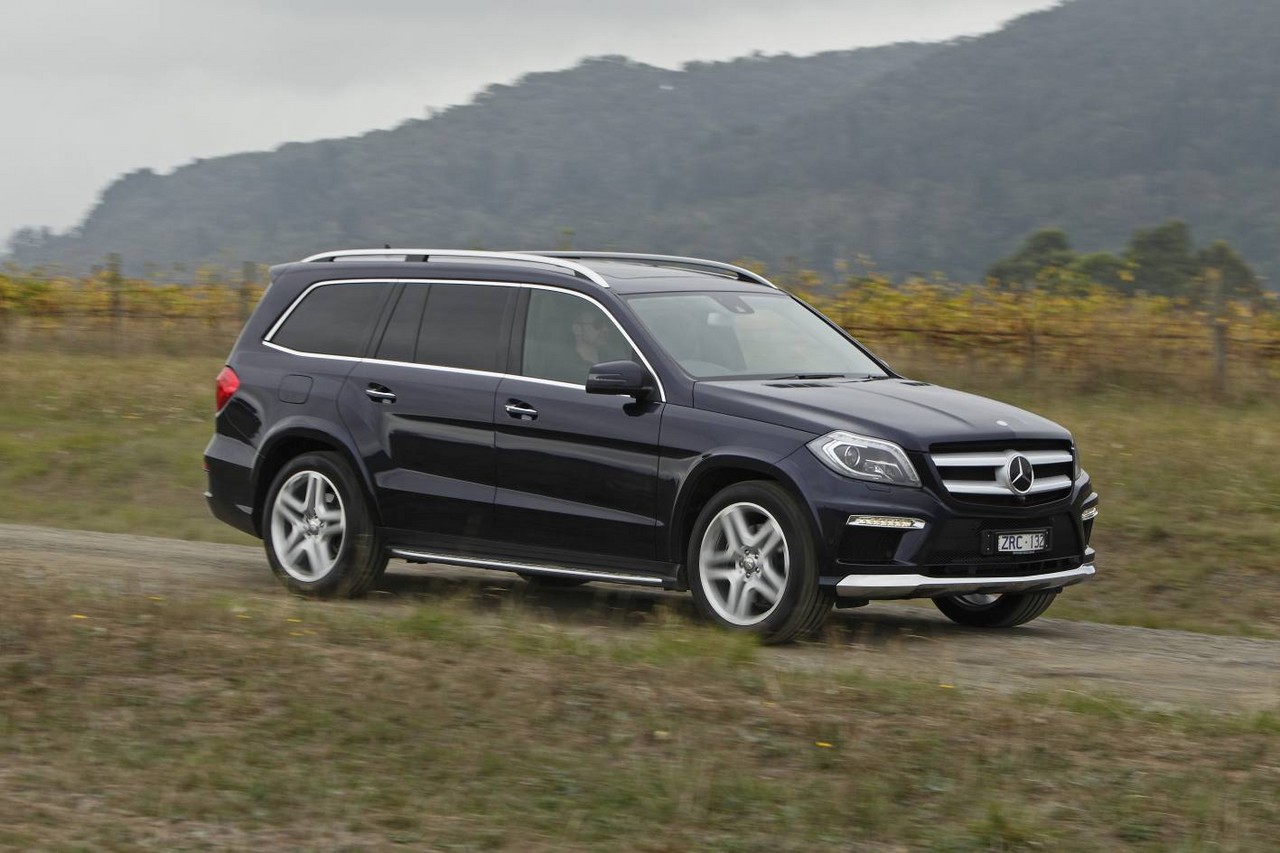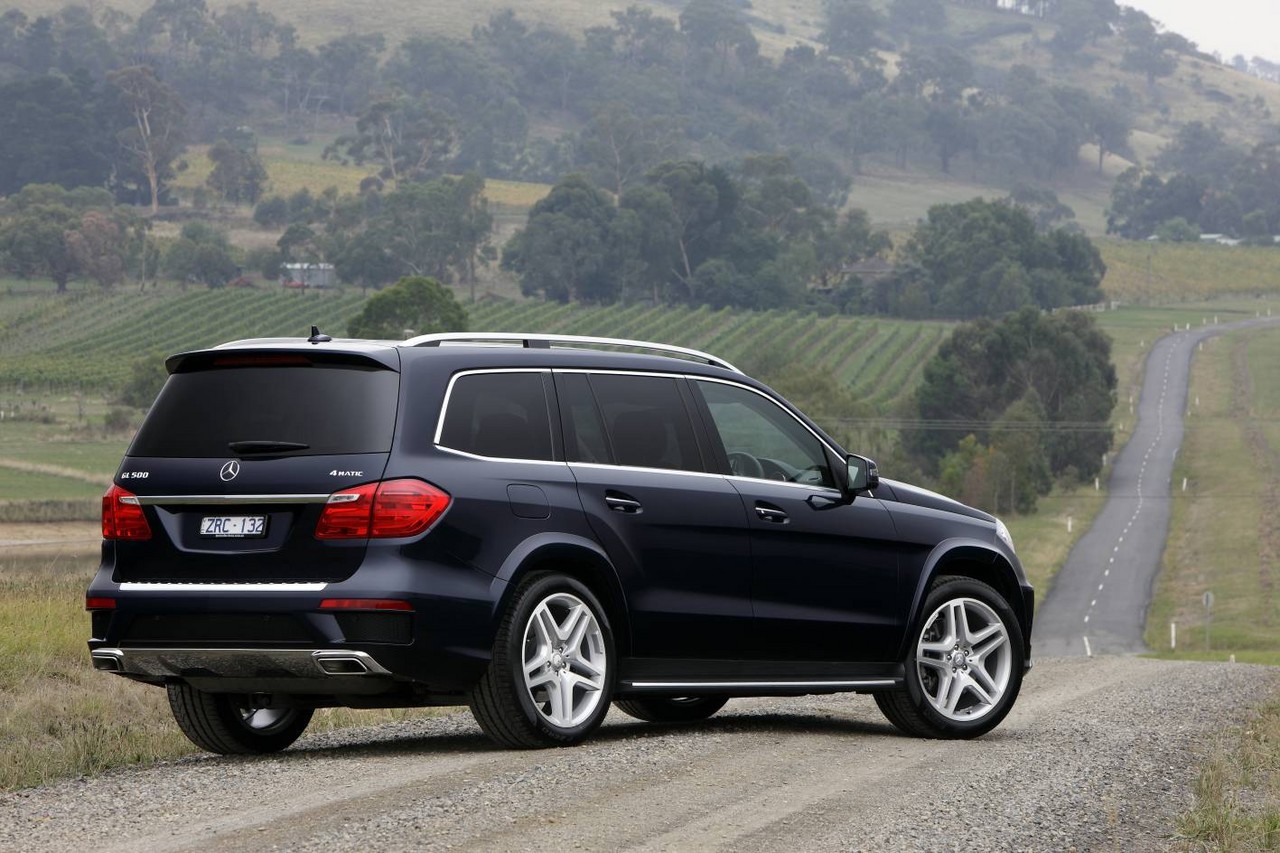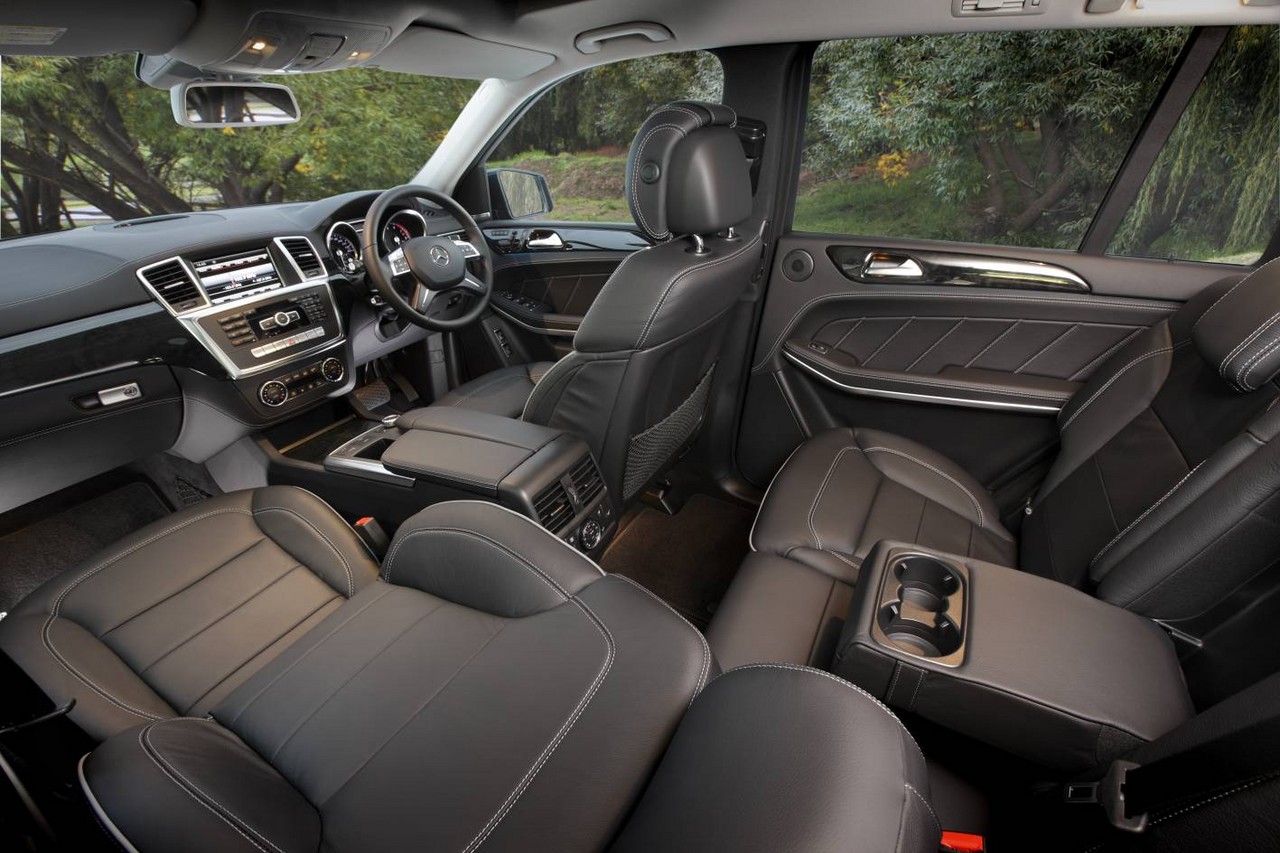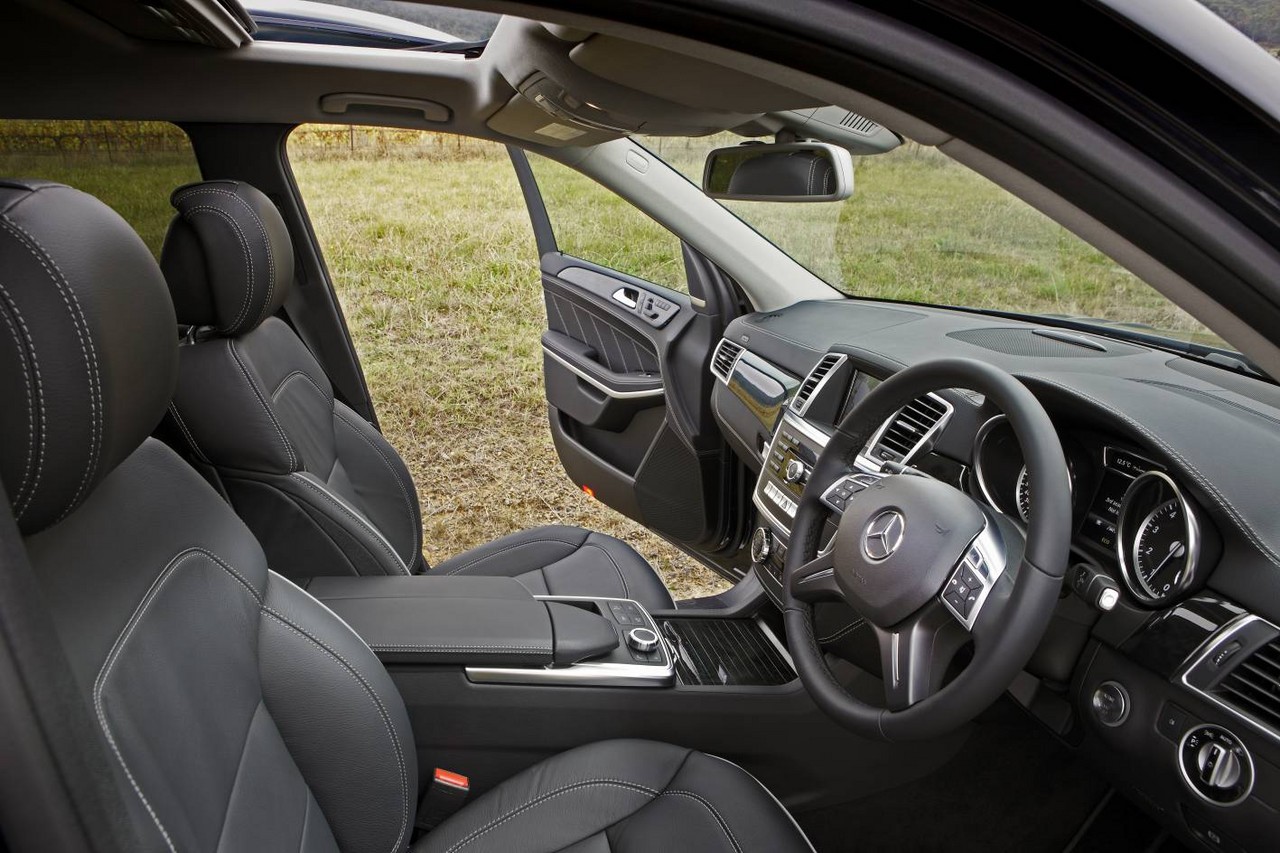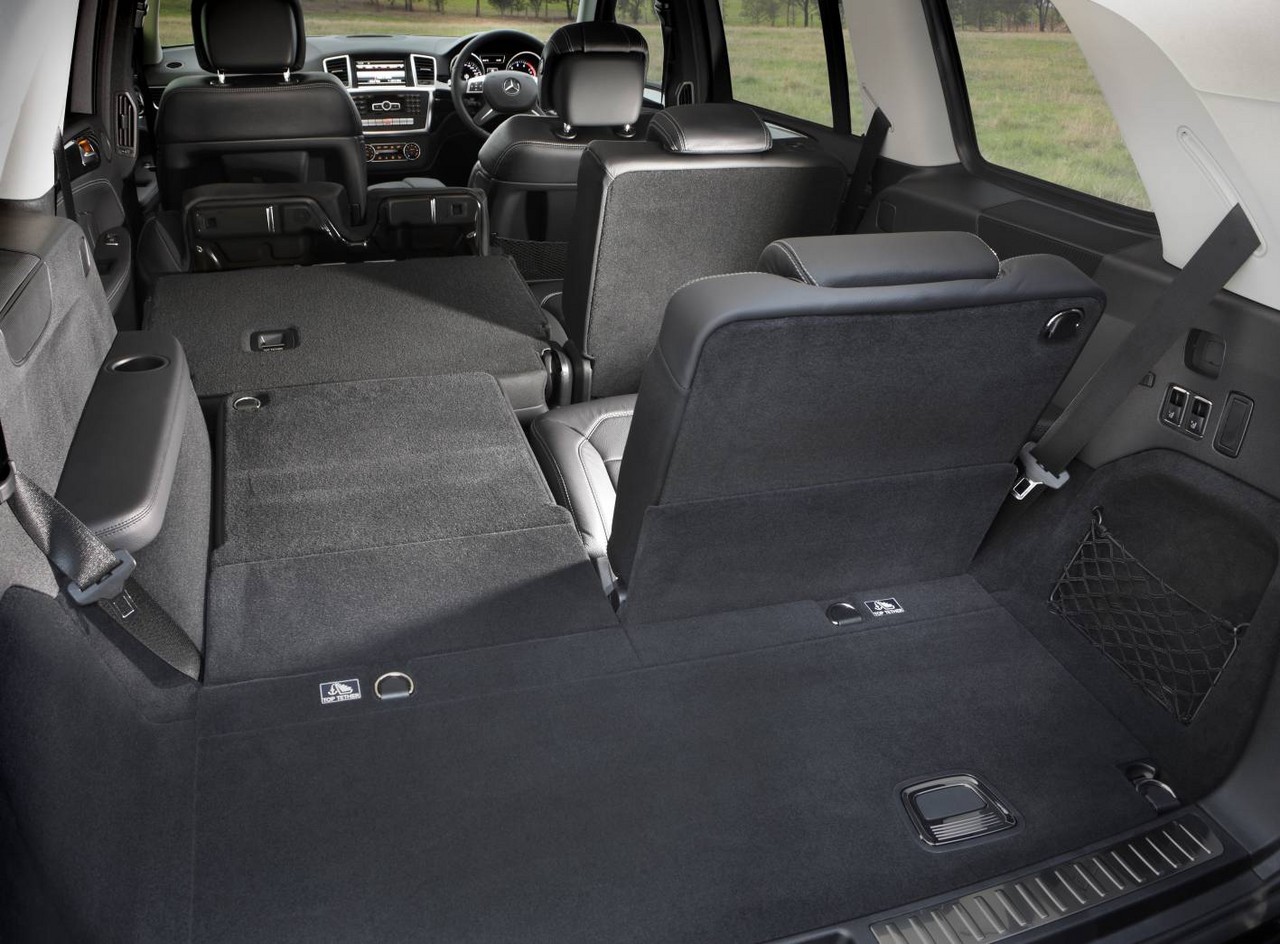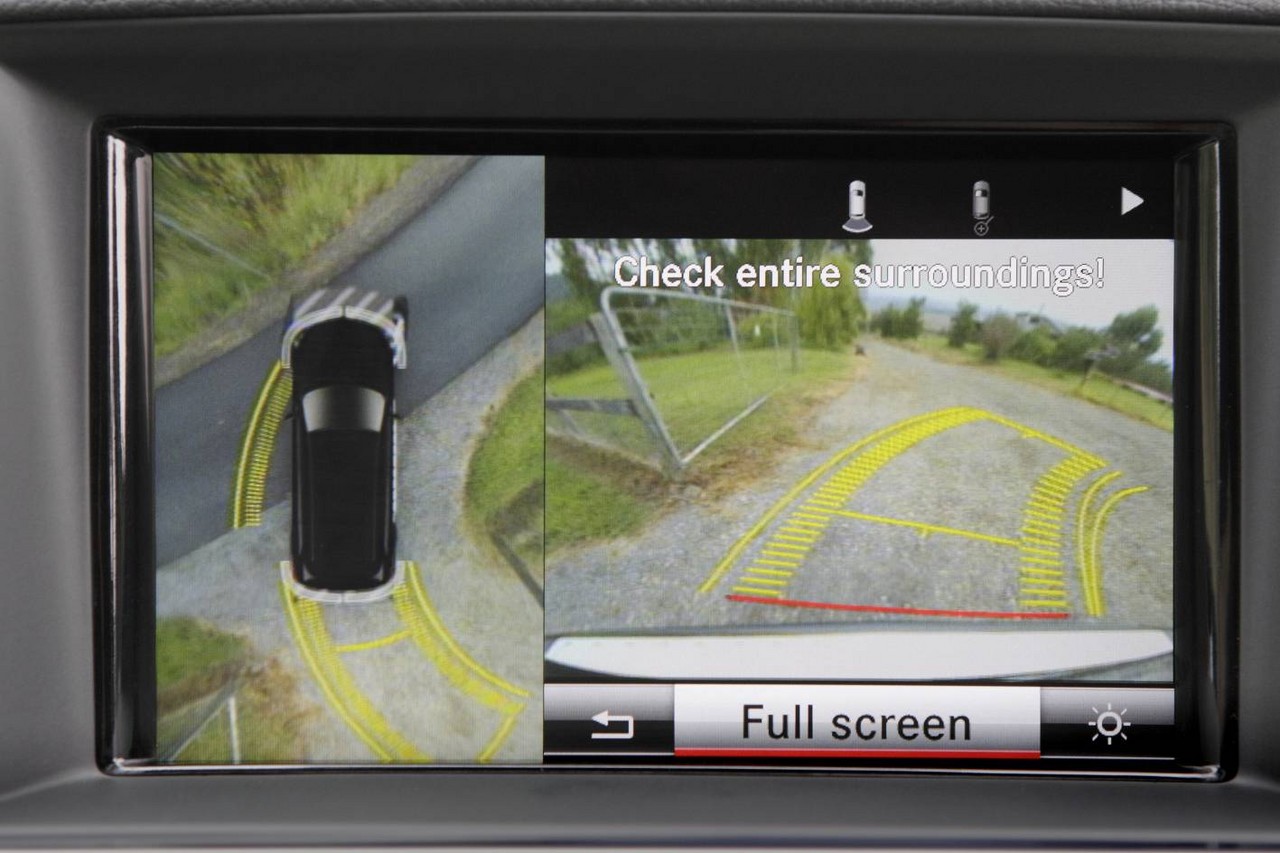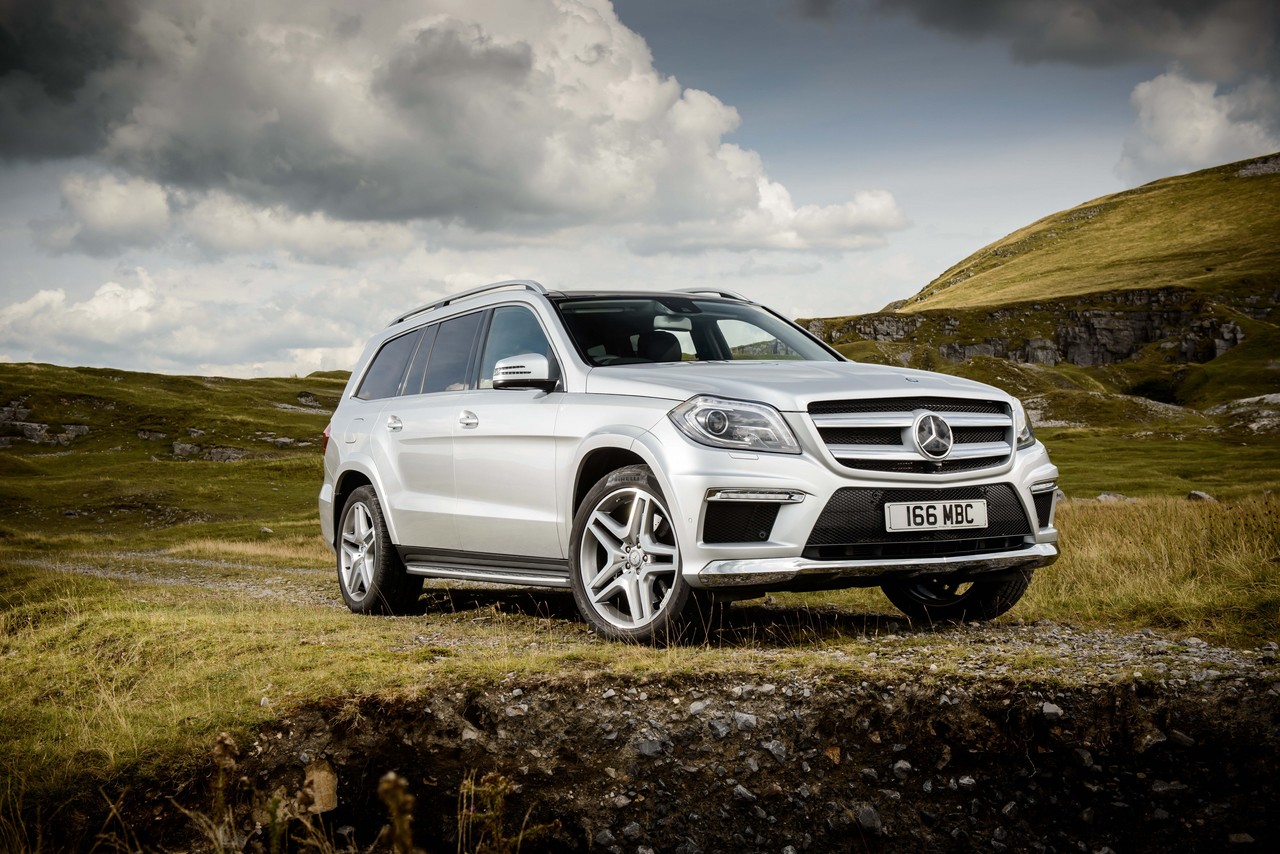
- Responsive and fuel-efficient turbo-diesel engines
- Comfortable ride and competent dynamics
- Spacious interior with usable third row seats
- High standard of interior fit and finish
- Artifically weighted steering lacks feel
- Brake pedal lacks initial response
- High fuel consumption for V8 engines
Overview
Released in Australia in May 2013, the Mercedes-Benz X166 GL-Class was a large, four-wheel drive wagon. Manufactured in Tuscaloosa, Alabama, the X166 GL-Class range consisted of the GL 350 BlueTec and GL 500 BlueEfficiency. Please note that the Mercedes X166 GL 63 AMG has been reviewed separately.
Engines: OM642 and M278
Of the engines,
- The GL 350 BlueTec was powered by a 3.0-litre OM642 V6 diesel engine which had an aluminium block and cylinder heads, common-rail fuel injection, a variable nozzle turbocharger, a counter-rotating balance shaft between the cylinder banks, double overhead camshafts and four valves per cylinder. Furthermore, the BlueTec system used urea injection to reduce the emission of nitrous oxides; and,
- For the GL 500 BlueEfficiency, the 4.6-litre M278 V8 petrol engine had an aluminium block, Silitec low-friction cylinder liners, twin turbochargers (one per cylinder bank) with maximum boost pressure of 0.9 bar, direct injection, multi-spark ignition, double overhead camshafts, variable valve timing and four valves per cylinder. The 4.6-litre V8 engine also had a stop-start function which enabled it to shut down when the vehicle is stationary in traffic.
Both engines had an ECO start/stop function which enabled the engine to shut down when the vehicle was stationary to conserve fuel. The GL 350 BlueTec and GL 500 BlueEfficiency both had seven-speed automatic transmissions (Mercedes-Benz’s ‘7G-Tronic’).
| Engine | Trans. | Peak power | Peak torque | |
|---|---|---|---|---|
| GL 350 BlueTec | 3.0-litre turbo-diesel V6 (OM642) | 7sp auto | 191 kW at 3600 rpm | 620 Nm at 1600-2400 rpm |
| GL 500 BE | 4.6-litre biturbo petrol V8 (M278) | 7sp auto | 320 kW at 5250 rpm | 700 Nm at 1800-3500 rpm |
4MATIC four-wheel drive
The Mercedes-Benz X166 GL-Class had a full-time four-wheel drive system (‘4MATIC’) with open differentials. In normal conditions, the 4MATIC system provided a 50:50 front:rear torque split. In the event that any wheel lost traction, the four-wheel traction control system (‘4ETS’) would brake that spinning wheel so that torque would be transferred to the wheels with grip.
For the GL 350 BlueTec and GL 500 BlueEfficiency, the ‘On & Offroad’ package included a centre differential lock, a two-stage transfer case with a low-range ratio, a protective underguard and an enhanced AIRMATIC system for maximum ground clearance of 285 mm and fording depth of 600 mm.
Dimensions
Compared to the Mercedes-Benz 164 GL-Class , the X166 GL-Class was 25 mm longer (at 5120 mm), 200 mm wider (2141 mm) and 10 mm taller (1850 mm), though wheelbase length was unchanged (3075 mm). Despite the increased dimensions and more rigid chassis, kerb weight was reduced by around 100 kg due to measures such as aluminium alloys for the front and rear axle links, a magnesium cross-member for the dashboard, an electric steering system, electric parking brake, engine support made of plastic and an aluminium brake booster.
Suspension
The Mercedes-Benz X166 GL-Class had double wishbone front suspension and independent, multi-link rear suspension. Furthermore, the suspension included Mercedes-Benz’s ‘Airmatic’ air suspension with Adaptive Damping System (ADS) which consisted of:
- Air-filled spring struts on the front axle with integral ADS dampers;
- Air springs with separate ADS dampers on the rear axle;
- Electric compressor with central pressure reservoir and pressure sensor;
- Air spring valves;
- Sensors for level control and damping control; and,
- An electronic control unit.
Airmatic air suspension could compensate for variations in vehicle load and driving state, while also acting as a level control system. For speeds above 70 km/h or when the ‘Sport plus’ mode was engaged, the air suspension would lower the body by 10 mm to reduce drag and increase stability. For off-road use, the air springs could increase ground clearance by up to 60 mm.
ADS was a fully automatic, electronically-controlled system which adapted the damping force at each wheel according to the road and driver behavior to reduce the forces exerted on the body by the movement of the wheels; the driver could also select from ‘Comfort’, ‘Sport’ and ‘Sport plus’ modes. ADS had four maps which it could use based on steering angle, turning angle sensors, vehicle speed and braking application:
- Level 1: soft rebound and soft compression for comfortable ride characteristics, suitable for little longitudinal and lateral acceleration;
- Level 2: soft rebound and firm compression (skyhook mode);
- Level 3: firm rebound and soft compression (skyhook mode); and,
- Level 4: firm rebound and firm compression, for minimising wheel load fluctuations when cornering and braking for more secure handling.
While Level 1 would be used for low levels of body movement, greater movement would result in the skyhook algorithm alternating between Levels 2 and 3 – by activating the fast-acting solenoid valves – to counter body roll and pitch. In more ‘dynamic’ handling conditions or when the ‘Sport’ or ‘Sport plus’ suspension modes were engaged, Level 4 would be used.
Safety equipment
Standard safety equipment for the Mercedes-Benz GL-Class included dual front airbags (two-stage), a driver’s knee airbag, front side airbags (combined thorax/pelvis airbag), full-length curtain airbags (i.e. for all three rows of seats), ABS, electronic brake force distribution, brake assist, electronic stability control, traction control, front seatbelt pre-tensioners and load limiting seatbelts for the front and outer second row passengers.
As standard, the X166 GL-Class was also fitted with:
- Pre-Safe: in the event that an accident was anticipated, Pre-Safe would prepare the vehicle by tensioning the front seat belts, inflating the air cushions in the multicontour seats and closing the sunroof and windows (if open);
- Distronic Plus (adaptive cruise control with brake warning): an ‘adaptive’ cruise control system which used two short-range radar sensors positioned behind the front bumper to monitor the road up to 30 metres ahead, and a long-range radar located behind the radiator grille which had a range of 200 metres. Operating at speeds up to 200 km/h, Distronic Plus used an electronic control unit to analyse the information from both radar systems to calculate the engine, automatic transmission and braking parameters required for proximity control. As such, Distronic Plus could automatically apply the brakes to prevent the vehicle from becoming too close to traffic ahead (the time interval could be specified) and accelerate back to the set speed when traffic allowed. To accelerate from rest, the driver only needed to operate the Distronic stalk on the steering column or briefly depress the accelerator pedal. With Distronic Plus, automatic deceleration of up to four (4) m/s2was possible. If Distronic Plus detected that heavier braking was required, a warning light would illuminate in the instrument cluster and be accompanied by an audible warning. Furthermore, the electronic proximity control system could be activated independently of Distronic Plus at speeds over 30 km/h to alert the driver if they were approaching another vehicle too rapidly;
- Brake Assist Plus: used a 24 GHz radar sensor with a range of 30 metres and a 77 GHz radar sensor with a range of 200 metres to monitor the distance to the vehicle ahead and would warn the driver if there was a risk of a collision. Brake Assist Plus could detect vehicles when travelling at speeds up to 200 km/h, and stationary objects when the driver was travelling at 7 km/h to 72 km/h. Significantly, Brake Assist Plus could calculate the necessary brake force assistance to prevent a rear-end collision, build up that pressure in the braking system and provide it as soon as the brake pedal was depressed for ‘the best possible deceleration’;
- Pre-Safe Brake (autonomous emergency braking): using two 24 GHz sensors behind the front bumper which had a range of 30 metres and a 77 GHz radar which had a range of 200 metres, Pre-Safe Brake operated at speeds between 30 km/h and 200 km/h, and at speeds below 70 km/h if the vehicle was approaching a stationary queue of traffic. Around 2.6 seconds before the anticipated moment of impact, an audible warning would sound and a red warning would appear in the tachometer. Around 1.6 before the calculated impact, the first stage of Pre-Safe Brake would initiate partial braking autonomously with around 40 per cent of the maximum braking power (approximately four (4) m/s2); the Pre-Safe occupant protections system would also be activated. If the driver then applied the brakes, maximum braking force would be made available. If the driver failed to react, Pre-Safe Brake would – in its second stage – initiate autonomous emergency braking (i.e. maximum braking power) around 0.6 seconds before the unavoidable collision to reduce the severity of the impact;
- Active Lane Keeping Assist: could detect when the adjacent lane was occupied (including oncoming traffic) and prevent the driver from inadvertently exiting from the lane when it was not safe to do so by applying a corrective braking force to the wheels on one side of the vehicle;
- Active Blind Spot Assistance: active at speeds above 60 km/h, a corrective braking force would be applied to the wheels on one side of the vehicle if the driver attempted to change lanes when a vehicle was detected in the driver’s blind spot; and,
- Attention Assist: operated at speeds in excess of 80 km/h and monitored driver behaviour and steering movements for signs of drowsiness; if detected, the driver would be provided with visual and audible warnings.
Furthermore, the GL 350 BlueTec and GL 500 BlueEfficiency were both fitted with an ‘active bonnet’ which would rise in the event of a pedestrian collision to cushion the pedestrian’s subsequent impact with the bonnet.
Features: Mercedes-Benz X166 GL 350 BlueTEC
Standard features for the Mercedes-Benz GL 350 BlueTEC included 20-inch alloy wheels with 275/50 R20 tyres, an eight speaker sound system with a CD/DVD player, MP3/WMA/AAC compatibility, 10GB music storage and auxiliary inputs (USB/iPod/memory card), COMAND APS with HDD satellite navigation and a 17.8 cm display, Bluetooth connectivity with voice recognition (‘Linguatronic’), four-zone climate control air conditioning (‘Thermotronic’), power adjustable and heated front seats, leather upholstery, cruise control with speed limiter, directional bi-xenon headlights with washers, daytime LED running lights, automatic headlights, rain-sensing wipers, front and rear parking sensors, four cameras for 360 degree surround views, park assist guidelines (Active Parking Assist), 40/60 split and folding second row seats, a leather-wrapped steering wheel with gearshift paddles, remote central locking, power windows and heated mirrors, power folding mirrors, a power adjustable steering column (for height and reach), a powered glass sunroof, electric parking brake, 12 volt power outlets, ambient lighting, roof rails, tinted windows, tyre pressure monitoring, a trip computer and an immobiliser.
As standard, the X166 GL-Class also featured ‘Active Parking Assist’ which used sensors on the front bumper to measure parking spaces and provided automated steering for the parking manoeuvre.
Features: X166 GL 500 BlueEfficiency
The Mercedes-Benz GL 500 BlueEfficiency was further equipped with 21-inch five-spoke AMG alloy wheels with 295/40 R21 tyres, multi-contour front seats, heated second row seats, keyless entry and start (‘keyless go’), power operated third-row seats (‘Easy-Entry’) and rear privacy glass. Visually, the GL 500 BlueEfficiency could be identified by its metallic paint finishes, AMG Exterior Sports Package which included flared wheel arches, black-painted B-pillar trim and chrome highlights (for the bumper, rub strips and boot lid). While the GL 350 BlueTec had Brown Eucalyptus interior wood trim, the GL 500 BlueEfficiency had Dark Graphite poplar wood trim.
Mercedes-Benz GL 350 BlueTec Limited Edition
Compared to the standard GL 350 BlueTec, the GL 350 BlueTec Limited Edition added 20-inch alloy wheels, a Harman Kardon Logic 7 surround sound system, keyless entry and start (‘keyless go’), and power folding second row seats for easier access to the third row (Mercedes-Benz’s ‘Easy Entry’).
Mercedes-Benz GL 350 BlueTec Edition S and GL 500 Edition S
The GL 350 BlueTec Edition S and GL 500 Edition S featured 21-inch AMG alloy wheels in matt black, a Harman Kardon Logic 7 surround sound system, multi-contour front seats, a wood/leather steering wheel, keyless entry and start (‘keyless go’), and power folding second row seats for easier access to the third row (Mercedes-Benz’s ‘Easy Entry’).
The GL 350 BlueTec Edition S and GL 500 Edition S were also fitted with Mercedes-Benz’s ‘Active Curve System’ which used active anti-roll bars on the front and rear axles to control body roll according to lateral acceleration, road speed and the suspension mode selected. When driving straight ahead, rotary actuators would decouple the two halves of the front and rear anti-roll bars so that they were not active. When the active anti-roll bars were operating,
- A hydraulic pump would feed oil to the anti-roll bar circuits;
- The active anti-roll bars had internal hydraulic rotary actuators with six-oil filled chambers, three of which were pressured for each direction of travel (i.e. cornering left or right). Furthermore, the front valve block had the task of distributing the oil flow between the front and rear axles, regardless of load; and,
- Pressure control valves and directional control valves that were integrated into the valve blocks at the front and rear axles would set the desired pressure and twist the active anti-roll bars in the appropriate direction.
The GL 500 Edition S was also fitted with a digital TV tuner, panoramic glass sunroof, rear sunblinds and alarm system.
Brochure
Related links
- Press Kit: Mercedes-Benz X166 GL-Class (July 2012)
- Specifications: Mercedes-Benz X166 GL-Class (July 2014)
- Mercedes-Benz Australia: Mercedes-Benz GL-Class
- Wikipedia.org: Mercedes-Benz X166 GL-Class
